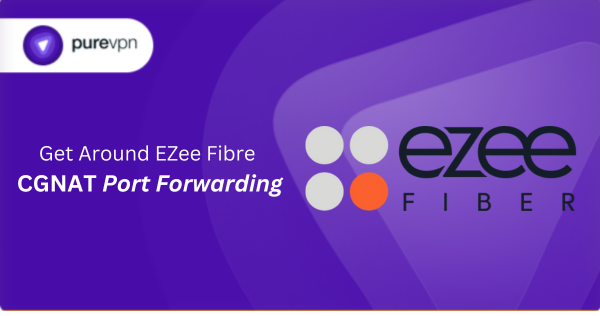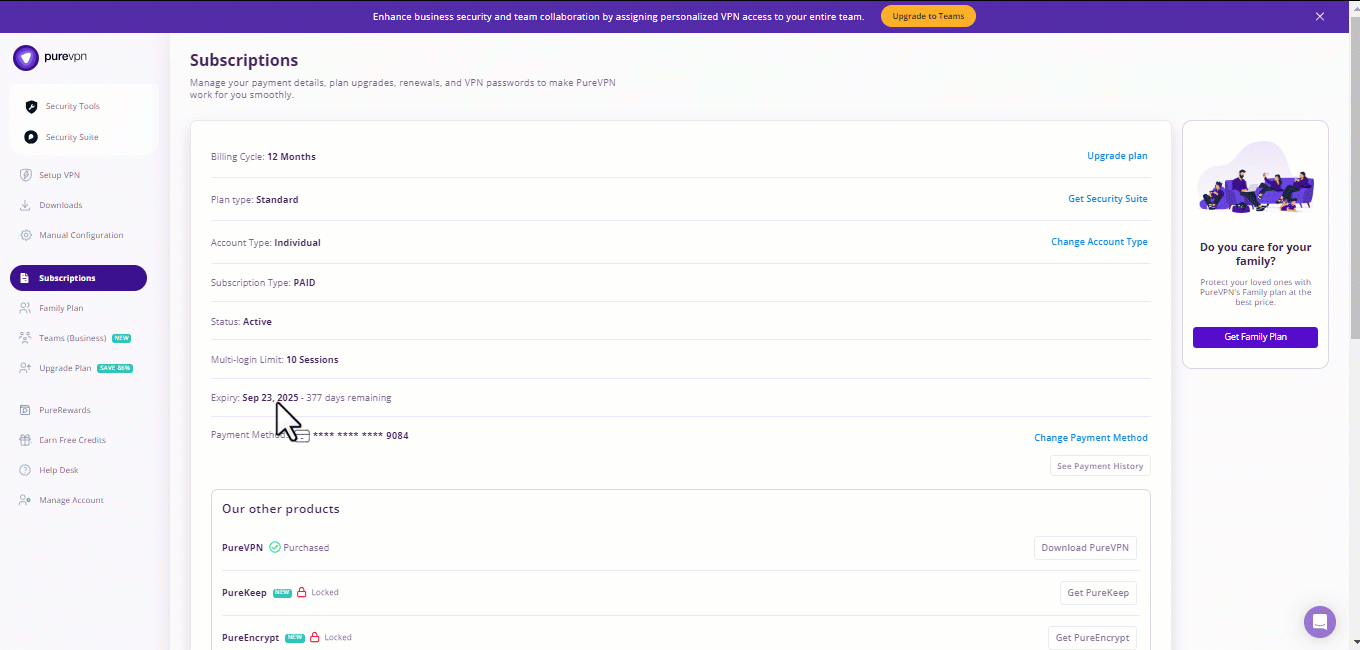If you’re an EZee Fibre customer trying to host a game server, remote desktop, security camera feed, or other inbound services only to discover port forwarding doesn’t work you’re likely behind Carrier‑Grade NAT (CGNAT). This scenario fundamentally changes how internet traffic reaches your home network. This guide explains how CGNAT works, why it breaks port forwarding, and the best methods to regain full inbound access.

What is CGNAT?
CGNAT (Carrier-Grade NAT) a type of network address translation (NAT) typically used by Internet service providers (ISPs). CGNAT allows multiple customers to share a single public IP address. This can help ISPs save money and resources, and it can also help reduce the number of IP addresses that need to be assigned to customers.
However, CGNAT can cause some problems for customers. For example, CGNAT can make it difficult or impossible for customers to host their websites or connect to certain types of online services. It can also make it difficult for customers to connect with other customers who are using routers behind CGNAT.
Suppose you’re having trouble connecting to certain websites or online services or having difficulty connecting with other customers who are using CGNAT. In that case, you can try contacting your ISP to see if they offer any options for alleviating these problems.
Understanding CGNAT and Why Standard Port Forwarding Fails
Carrier‑Grade NAT (CGNAT) is used by many ISPs, including EZee Fibre to conserve scarce IPv4 addresses by letting multiple households share one public IP. Your router’s WAN IP often falls within the 100.64.0.0–100.127.255.255 range, an internal address used by CGN routers ([turn0image7], [turn0search12]). That means:
- Your home router has a private WAN IP, not a unique public IP.
- You do not own the ultimate public address that traffic hits.
- Classic port forwarding inside your router can’t direct inbound traffic from the internet to your internal device.
As a result, services that depend on inbound connections (like remote desktop, self-hosted servers, or gaming) simply won’t work through standard configuration.
Why CGNAT Blocks Port Forwarding on EZee Fibre
On EZee Fibre:
- Many users report that port forwarding stopped working without changing anything after CGNAT implementation ([turn0search0], [turn0search7]).
- Because inbound ports reach the ISP’s NAT layer first, any forwarding rule in your local router is bypassed.
- Unless your router WAN IP matches your public IP, forwarding is futile.
How to Check If You’re Behind CGNAT
Here are multiple steps by which you can check if your ISP is using CGNAT CGNAT.
| Step | What to Do |
|---|---|
| 1 | Log into your router and view the WAN IP address. |
| 2 | Compare it with your external public IP (via “what is my IP”). |
| 3 | If WAN IP is in the CGNAT range (e.g. 100.64.x.x) and differs from public IP, you’re behind CGNAT. ([turn0search4], [turn0search12]) |
If confirmed, traditional port forwarding will not work even if configured correctly on your router.
How to Get Port Forwarding Working with EZee Fibre CGNAT
Option 1: Request a Static Public IP
Contact EZee Fibre support and ask for a public static IPv4 address. Some ISPs offer this for a fee. As seen in fiber ISPs like Community Fibre, port forwarding becomes possible again once you leave CGNAT ([turn0search2], [turn0search8]).
Once assigned:
- Your router gets a public WAN IP.
- Standard port forwarding works again from your local router.
Option 2: Use PureVPN’s Port Forwarding Addon

If you want to port forward on Ezee Fibre without CGNAT barriers, using PureVPN’s Port Forwarding add-on is the easiest way. Here’s how to do it:
- Sign up for PureVPN, include the Port Forwarding add-on, and complete your payment.
- Download and install the PureVPN app for your device and log in with your account details.
- Open the Member Area, click Subscriptions and then Configure next to Port Forwarding.
- Select Enable specific ports, enter the ports you wish to forward, and click Apply Settings.
- Connect to a port forwarding-supported server to activate your settings and bypass CGNAT limitations!
Option 3: Use a VPS as Middleman
Set up a cloud VM with a public IP:
- Tunnel traffic from the VPS to your home router via SSH or VPN.
- Use the VPS as your accessible endpoint.
This method is more involved but flexible for advanced setups ([turn0search2]).
Setting Up VPN + Port Forwarding (Example)
- Subscribe to a port‑forwarding VPN.
- Configure the VPN on a device in your home network (router or dedicated host).
- Receive your external IP and port mappings from the VPN provider.
- Forward ports from VPN interface inward to local devices.
- Test from an external IP to ensure connectivity.
You now bypass CGNAT and regain full control of inbound ports even though you remain under EZee’s network.
Comparison of Solutions
| Method | CGNAT Bypass | Requires ISP Action | Security | Complexity | Cost |
|---|---|---|---|---|---|
| Request Static IP from EZee | ✅ | ✅ | Low/Medium | Simple | May be paid |
| VPN with Port Forward | ✅ | ❌ | Medium | Moderate | Ongoing VW setup |
| VPS Tunnel (Cloud middleman) | ✅ | ❌ | Medium | Advanced | VPS costs + setup |
Real-World Scenario: Hosting a Game Server
You want to host a Minecraft server:
- Local machine IP:
192.168.1.25, port 25565. - Your router’s WAN IP:
100.64.12.34(CGNAT) vs public IP:203.0.113.45.
Without workaround: port 25565 cannot forward through CGNAT.
With VPN solution:
- Tunnel with PureVPN → obtain public IP.
- Forward port 25565 via VPN to internal
192.168.1.25. - Friends join via public VPN-assigned IP.
- Full connectivity secured under encryption, bypassing ISP.
Security & Privacy Considerations
- Be cautious when exposing services—only forward necessary ports.
- VPNs help maintain encryption and avoid exposing your local network.
- Cloud tunnels should be secured and not expose unnecessary services.
How Can I Port Forward on My Router behind EZee Fibre CGNAT:
When your router’s WAN IP falls in the 100.64.0.0/10 CGNAT range and doesn’t match your public IP, EZee Fibre is using CGNAT, blocking inbound port forwarding. To fix this:
- Request a static public IPv4 from EZee Fibre.
- Or use a VPN service with port forwarding support (e.g., PureVPN).
- Or set up a VPS tunnel to act as a middleman with a public IP.
Each method bypasses CGNAT, re-enabling inbound port access to your home services.
The Hybrid Access Strategy
Rather than relying solely on one approach:
- Use static IP from ISP for essential services requiring stability.
- Simultaneously use a VPN or tunnel as a backup or for testing new services.
This hybrid approach gives you redundancy if ISP DNS-based changes occur, and flexibility to quickly deploy new servers behind VPN tunnel without overhauling router settings.
Final Thoughts
- EZee Fibre CGNAT prevents traditional port forwarding because you don’t control a public IP.
- Requesting a static IP is the most direct fix—but may come at a cost.
- VPN with port forwarding offers flexibility without dependency on ISP.
- Cloud tunneling via VPS is ideal for power users.
- For best results, combine these options to build resilient remote access infrastructure.





